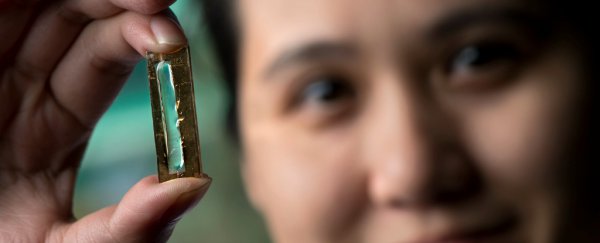When it comes to the lab, accidents aren't usually a good thing, but an unexpected result has led chemists to a system that could make batteries last up to 400 times longer than the best-performing batteries today.
While the new battery would still need to be recharged, the big difference is it would keep working efficiently over 200,000 charge cycles - which is pretty much a lifetime of use when it comes to devices such as phones, computers, cars, and even spacecraft. And it's a whole lot longer than the lifespand of today's lithium batteries.
The accident part is that the researchers still aren't sure exactly how the system works.
"We started to cycle the devices, and then realised that they weren't going to die," lead researcher Reginald Penner from the University of California, Irvine, told Popular Science. "We don't understand the mechanism of that yet."
Instead of lithium, the new batteries store electricity in gold nanowires. The original aim of the experiment was simply to make a solid-state battery that used an electrolyte gel rather than a liquid to hold its charge - lithium batteries contain liquid, which makes them extremely combustible and also sensitive to temperature.
But when they started experimenting with gold nanowires suspended in this electrolyte gel, they found that the system was incredibly resilient. In fact, it was way, way more resilient than any other battery system.
The gold nanowires are thousands of times thinner than a human hair, and the team isn't the first to use them to store electricity along their length. But in the past, these systems had been brittle and prone to cracking.
The addition of the electrolyte gel by PhD candidate Mya Le Thai seems to have made all the difference, as well as coating the nanowires in manganese oxide.
"Mya was playing around, and she coated this whole thing with a very thin gel layer and started to cycle it," said Penner. "She discovered that just by using this gel, she could cycle it hundreds of thousands of times without losing any capacity."
"That was crazy," he added, "because these things typically die in dramatic fashion after 5,000 or 6,000 or 7,000 cycles at most."
With normal batteries, the more you charge and recharge them, the less efficient they become. After a few hundred charge cycles, they generally only contain a small amount of charge - as anyone who has a laptop or phone older than a few years will be well aware of.
But testing showed that the new system could withstand 200,000 charge cycles over three months and only lose 5 percent of its capacity.
The team stresses that the system they've built isn't a battery just yet, so to be clear, there's no guarantee that this efficiency will be maintained when scaled up into a device you could use in your phones or laptops - or that it'll work at all.
The other bad news is that any batteries using gold are going to be expensive no matter how tiny the gold nanowires are, so the team is now experimenting with nickel instead, to see if they can achieve similar results.
Oh and there's also the small matter of figuring out exactly why the system works so well. Once they know that, it'll help the team tweak the battery system to make it more practical and affordable for real-world applications. Who knows, they might even be able to make it last even longer. Although if you ask us, a lifetime is more than enough, thank you.
The research has been published in Energy Letters.
